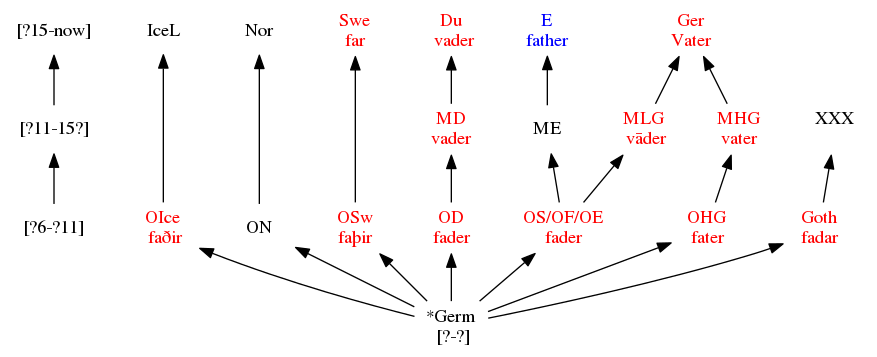The online OED (see bottom for url ) contains a lot of information about a word, including ‘etymological’ information on the words ‘origin‘. This info is given near the top of an entry in very terse format, making it accessible really only to specialists. There are several things that could be done to generate portrayals of the information that would perhaps permit ‘at a glance’ comprehension by the non-specialist, and help more people understand the remarkable extent to which English words share deep ancestry with many European and even non-European languages. Aspects of this are outlined below. There is also a a short recording explaining things further
http://www.scss.tcd.ie/Martin.Emms/ProjVids2021/oed_etymology-recording.mp4
Here’s the raw text from the OED online for for ‘father’
Cognate with Old Frisian fader , feder (West Frisian faar ), Old Dutch fadar , fader (Middle Dutch vāder , Dutch vader ), Old Saxon fadar , fader (Middle Low German vāder ), Old High German fater (Middle High German vater , German Vater ), early Scandinavian (runic: Sweden) faþiR , Old Icelandic faðir , Norn (Orkney) fa , (Shetland) fy (definite form fyrin ), Old Swedish faþir (Swedish fader , (now usually) far ), Old Danish fathær (Danish fader , (now usually) far ), Gothic fadar (in an isolated attestation in Galatians 4:6; the ordinary word is atta : see dad n.1), < the same Indo-European base as Sanskrit pitṛ , Old Avestan ptar (Younger Avestan pitar ), ancient Greek πατήρ , classical Latin pater ( > Old French paire , pedre , Old French, Middle French pere , French père , Old Occitan, Occitan paire , Catalan pare , Spanish padre , Portuguese pãe , Italian padre ), Oscan patir , Gaulish ater- , atr- , Early Irish athair , Armenian hayr , Tocharian A pācar , Tocharian B pācer
here are regularities in the way the text is put together that allow it to be ‘parsed’ and from the parse to generate alternative portrayals. Below is a quick indicative at portrayal of some aspects via a HTML table:
| Language Name | Child Language Name | Words |
|---|---|---|
| Old Frisian | fader , feder | |
| West Frisian | faar | |
| Old Dutch | fadar , fader | |
| Middle Dutch | vāder | |
| Dutch | vader | |
| Old Saxon | fadar , fader | |
| Middle Low German | vāder | |
| Old High German | fater | |
| Middle High German | vater | |
| German | Vater | |
| Old Icelandic | faðir | |
| Old Swedish | faþir , | |
| Swedish | fader , (now usually) far | |
| etc | etc | etc |
There are temporal aspects which might be portrayed by an automatically generated graphic, along the lines roughly illustrated by the image below
There are temporal aspects which might be portrayed by an automatically generated graphic, along the lines roughly illustrated by the image below

There also spatial aspects to see the geographical region associated with the languages mentioned (Gothic? Avestan? Sanskrit? Tocharian?) Such visualisations might give the non-specialist an entry into notions underpinning the idea of an Indo-European language family.
[to access the OED via Trinity’s subscription go to https://www.tcd.ie/library/ then ‘Databases and E-books’ then ‘O’ and ‘Oxford English Dictionary’. Note this is not ‘just’ an online Oxford dictionary, but the OED has a particular mission of documenting the history of the language; you might want to look these slides of a talk I once gave which in part give the mission and origin of the OED here
